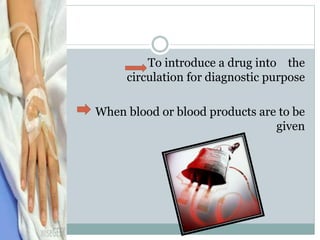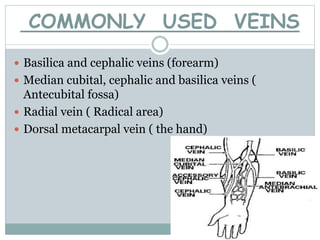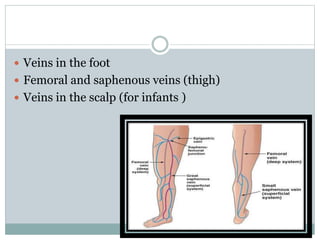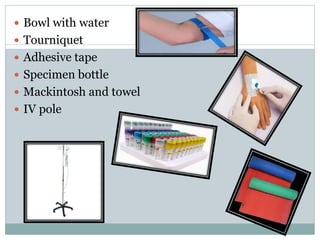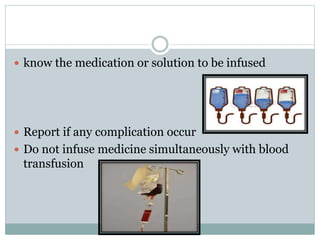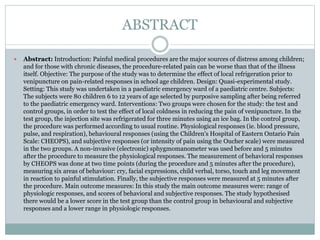Venipuncture ppt
- 1. AHIMA ELIAZER SC NURSING 1ST YEAR TMCON
- 3. OBJECTIVE At the end of the class student will be able to Define Venipuncture Explain the purpose of venipuncture Enlist the indication of venipuncture What should be observed during the procedure Enlist the equipment used Explain the procedure of venipuncture Discuss the complication of venipuncture Explain the Nursing Responsibilities
- 5. DEFINITION “ enipuncture is the process of obtaining intravenous access for the purpose of intravenous therapy or for blood sampling of venous blood”.
- 6. In other words “Venipuncture is puncturing vein with sterile cannula/ needle into a vein to supply the blood with fluids, electrolyte , nutrients and medication”.
- 8. INDICATION To save the patient in life-threatening situation To supply fluids and nutrients to the patient who are unable to digest or absorb a diet administered mouth or through the nasal tube
- 9. To introduce a drug into the circulation for diagnostic purpose When blood or blood products are to be given
- 10. SOLUTION USED
- 11. COMMONLY USED VEINS Basilica and cephalic veins (forearm) Median cubital, cephalic and basilica veins ( Antecubital fossa) Radial vein ( Radical area) Dorsal metacarpal vein ( the hand)
- 13. Veins in the foot Femoral and saphenous veins (thigh) Veins in the scalp (for infants )
- 15. GENERAL INSTRUCTION Follow strict aseptic technique Administer IV fluids only with a clearly written prescription
- 16. Observe the rights during administration Check the expiry date before opening the bottles. Do not use any site that is tender, red, edematous and inflamed
- 17. Keep the patient warm and comfortable with blanket if necessary Immobilize the joints with splints when the needle is placed near a joint Frequent observation of the vital signs throughout the procedure will help to detect many complication
- 18. Never allow the bottle to get empty completely to prevent the entry of air into the tissues Allow the patient to void before the IV infusion is started.
- 19. Maintain the specified rate of flow to prevent circulatory overload If fluids are discolored , cloudy in appearance that should not be used for infusion
- 21. EQUIPMENT A tray containing Sterile IV Solution Sterile IV infusion set
- 22. Sterile needle of choice ( cannula )
- 23. PARTS OF CANNULA
- 24. Sterile syringe (2 or 5 ml)
- 25. Sterile transfer forceps in a jar Sterile cotton swabs and gauze pieces Surgical spirit Kidney tray and paper bag
- 26. Bowl with water Tourniquet Adhesive tape Specimen bottle Mackintosh and towel IV pole
- 27. PRELIMINARY ASSESSMENT CHECK Patient name, age, bed no and diagnosis Purpose of infusion Doctor’s order Level of consciousness General condition Abilities and limitations Need for additional restraints Articles available Previous experience
- 30. Prepare the IV solution ; insert the drip set, and the air went into the bottle openings
- 31. Hang the bottle on the IV pole about 18-24inches high Over the clamp and flush the IV fluid through the tubing and needle into the kidney tray until all air is removed
- 32. Prepare few strips of adhesive tapes and keep ready for use Apply tourniquet firmly 6-8 inches proximal to the venipuncture site. Lightly tap the vein with your fingertips.
- 33. Clean the area with surgical spirit Insert the needle into vein by holding the needle at a 30’C angle with the hovel up. Pierce the skin lateral to the vein
- 34. When back flow of blood occurs into the needle and tubing, insert the needle further up into the vein about ¾ or 1 inch Release the tourniquet and open the clamp to allow the fluid to run in.
- 37. Take consent Know the protocols and procedures related to access device used Use a sterile spirit cotton
- 38. know the medication or solution to be infused Report if any complication occur Do not infuse medicine simultaneously with blood transfusion
- 39. Before inserting make sure that the drug is ready for administration Discard the waste and sharp at appropriate bin
- 40. ABSTRACT Abstract: Introduction: Painful medical procedures are the major sources of distress among children; and for those with chronic diseases, the procedure-related pain can be worse than that of the illness itself. Objective: The purpose of the study was to determine the effect of local refrigeration prior to venipuncture on pain-related responses in school age children. Design: Quasi-experimental study. Setting: This study was undertaken in a paediatric emergency ward of a paediatric centre. Subjects: The subjects were 80 children 6 to 12 years of age selected by purposive sampling after being referred to the paediatric emergency ward. Interventions: Two groups were chosen for the study: the test and control groups, in order to test the effect of local coldness in reducing the pain of venipuncture. In the test group, the injection site was refrigerated for three minutes using an ice bag. In the control group, the procedure was performed according to usual routine. Physiological responses (ie. blood pressure, pulse, and respiration), behavioural responses (using the Children's Hospital of Eastern Ontario Pain Scale: CHEOPS), and subjective responses (or intensity of pain using the Oucher scale) were measured in the two groups. A non-invasive (electronic) sphygmomanometer was used before and 5 minutes after the procedure to measure the physiological responses. The measurement of behavioral responses by CHEOPS was done at two time points (during the procedure and 5 minutes after the procedure), measuring six areas of behaviour: cry, facial expressions, child verbal, torso, touch and leg movement in reaction to painful stimulation. Finally, the subjective responses were measured at 5 minutes after the procedure. Main outcome measures: In this study the main outcome measures were: range of physiologic responses, and scores of behavioral and subjective responses. The study hypothesised there would be a lower score in the test group than the control group in behavioural and subjective responses and a lower range in physiologic responses.
- 41. Results: Results showed no significant difference between the two groups for physiological responses (before and after procedure). However behavioural responses during and after the procedure (p=0.0011), and subjective responses after the procedure (p=0.0097) were significantly lower (ie. the test group had lower scores in behavioural and subjective responses compared to the control group. Conclusion: The results of this study suggest that the use of local refrigeration prior to venipuncture can be considered an easy and effective intervention of reducing venipuncture-related pain.
- 42. IBLIOGRAPHY Rebecca Nissanka, Comprehensive textbook of foundation of nursing Page No. 273-275 Ratna Prakash , Manipal manual of Nursing procedure Page No. 145-146 Sr Nancy, Principles and practice of nursing ,Page No. 154-155 Taylor Lillis Fundamentals of nursing , Page No. 326-328









